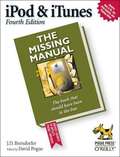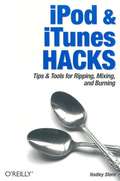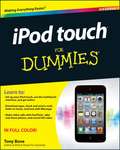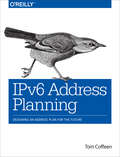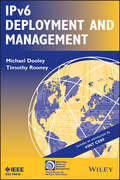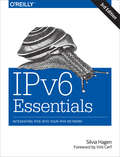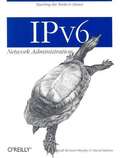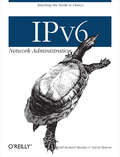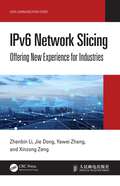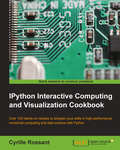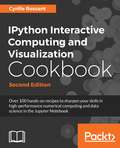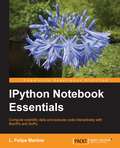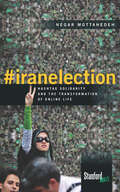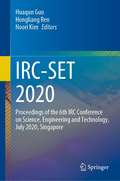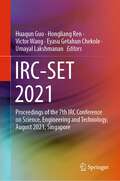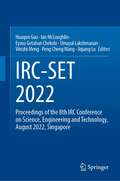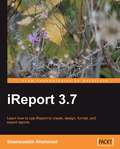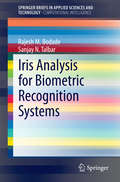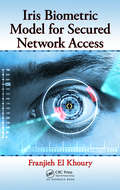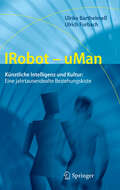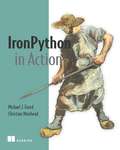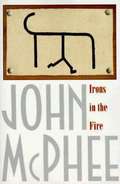- Table View
- List View
iPod & iTunes: The Missing Manual, 4th Edition
by J. D. BiersdorferiPod is the dominant digital music player on the market, and for the first time, Apple gets to feel like Microsoft. iPod steadily evolved through five generations since then, and today the dynasty ranges from a screenless 512-megabyte version that can hold plenty of songs for your gym routine to a 60-gigabyte multimedia jukebox that can spin out an entire season of "Desperate Housewives", along with thousands of color photos and all that colorful music. An iPod is many things to many people, but it can be much more than most people realize. That's where iPod and iTunes: The Missing Manual comes in. Like the device itself, this book is a long-running bestseller, now in its fourth edition. What makes it so popular is the wealth of useful information it brings to anyone who breaks open iPod's distinctive packaging- especially since Apple doesn't supply a manual of its own. Once again, we've updated this guide to fully explain the ins and outs of iPod, including the nano, the shuffle, and all the latest features and uses, such as: The 5th generation Video iPod, which can hold 15,000 songs, 25,000 photos, and 150 hours of video. iTunes 6, where you can buy tunes, subscribe to Podcasts, tune into internet radio, download videos, build playlists, and more. Going beyond the music to use iPod as an external drive, an eBook, a personal organizer, a GameBoy, and a slide projector. Extreme iPodding with shareware and AppleScripts, using an iPod with external speakers (including the car stereo), accessories, and troubleshooting. It's been five years since iPod hit the scene, but, clearly, the evolution has only just begun. iPod and iTunes: The Missing Manual gives you everything you need to evolve with it.
iPod & iTunes Hacks
by Hadley SternSome people are content to use their iPod simply to play music. Some people want to do much more. Those people, and you know who you are, aren't satisfied until they get under the hood and tap every iPod trick available to them. They want to explore and experiment, create shortcuts, and unearth cool and unexpected things to do with their iPod that have never even occurred to their friends. Maybe they want to use their iPod to read email. Maybe they want to use it as a voice recorder, or a device to store their digital photos. Maybe they want to use iTunes visuals as a screensaver, use Java to expand iTunes functionally, or use a cheap Linux box as a server and access MP3 tunes. Or, maybe they just want to paint their iPod a custom color. For those people who want to get more much more out of their iPod iPod and iTunes Hacks is brimming with undocumented tips, tricks, and trade secrets for getting the very most from your iPod. This guide takes curious and clever iPod owners beyond the obvious with 100 ingenious hacks that will delight, entertain, and add astonishing power to the iPod and iTunes experience.
iPod touch For Dummies, 3rd Edition
by Tony BoveThe ultimate beginner guide to the iPod touch, now updated and in full-color! Part media player, portable game console, and breakthrough Internet device, you could say that the iPod touch is one ideal gadget. With this new, full-color edition, bestselling For Dummies author Tony Bove walks you through powering up your iPod touch, personalizing it, establishing a Wi-Fi connection, and synchronizing your data. You'll also explore how to surf the web, rent movies, buy songs, send and receive e-mail, get directions, check stocks, organize photos, watch videos, keep a calendar, and much more. Plus, you'll learn about the new features of iOS 5 and how to access hundreds of thousands of apps that help you do even more with your iPod touch. Covers powering up your iPod touch, getting comfortable with the multitouch interface, personalizing your iPod touch, and establishing a Wi-Fi connection Walks you through the basics of the iTunes store so you can buy, download, and play music, TV shows, podcasts, movies, and more Demonstrates how to synchronize your data, work with the calendar, organize and share photos, browse the Internet, send and receive e-mail, read e-books, and get directions Helps you use your iPod touch to stay connected with social media sites like Facebook and Twitter Explains how to video chat with FaceTime, sync with iCloud, and use the new iOS 5 features Guides you through resetting, updating, restoring, and troubleshooting your iPod touch Fully revised for iOS 5 and the latest iPod touch models, iPod touch For Dummies, 3rd Edition puts you totally in charge of your iPod touch!
iPolitics: Citizens, Elections, and Governing in the New Media Era
by Richard L. Fox Jennifer M. RamosPoliticians rely on Twitter, Facebook and YouTube to exercise political power. Citizens around the world also use these tools to vent political frustrations, join political groups and organize revolutions. Political activists blog to promote candidates, solicit and coordinate financial contributions and provide opportunities for volunteers. iPolitics describes the ways in which new media innovations change how politicians and citizens engage the political arena. Among other things, contributors to this volume analyze whether the public's political knowledge has increased or decreased in the new media era, the role television still plays in the information universe, the effect bloggers have had on the debate and outcome of healthcare reform, and the manner in which political leaders should navigate the new media environment. While the majority of contributors examine new media and politics in the United States, the volume also provides a unique comparative perspective on this relationship using cases from abroad.
IPv6 Address Planning
by Tom CoffeenIf you're ready to join the move to IPv6, this comprehensive guide gets you started by showing you how to create an effective IPv6 address plan. In three example-driven sections--preparation, design, and maintenance--you'll learn principles and best practices for designing, deploying, and maintaining an address plan far beyond what's possible with IPv4 networks.During the course of the book, you'll walk through the process of building a sample address plan for a fictional company. Enterprise IT network architects, engineers, and administrators will see firsthand how IPv6 provides opportunities for creating an operationally efficient plan that's scalable, flexible, extensible, manageable, and durable.Explore IPv6 addressing basics, including representation, structure, and typesManage risks and costs by using a three-phase approach for deploying IPv6Dig into IPv6 subnetting methods and learn how they differ from IPv4Determine the appropriate size and type of the IPv6 allocation you requireApply current network management tools to IPv6Use IPv6 renumbering methods that enable greater network scale and easier integrationImplement policies and practices to keep IPv6 addresses reachable
IPv6 Deployment and Management (IEEE Press Series on Networks and Service Management #22)
by Michael Dooley Timothy RooneyWith the announcement in 2011 that the current Internet Protocol (IP), IPv4, has nearly run out, interest in IPv6 -- the latest IP version -- has grown substantially. This book describes IPv6 technology and its repercussions on organizations, including strategies and techniques for assessing the impact of deploying IPv6 on a network, discovering current IP assets, assessing network readiness, creating a plan to deploy IPv6 while retaining IPv4 connectivity, and for managing a dual protocol IPv4-IPv6 network. It is a must read for IP network engineers, managers, and those who work in IT.
IPv6 Essentials 3rd Edition
by Silvia HagenIPv6 Essentials, Second Edition provides a succinct, in-depth tour of all the new features and functions in IPv6. It guides you through everything you need to know to get started, including how to configure IPv6 on hosts and routers and which applications currently support IPv6. The new IPv6 protocols offers extended address space, scalability, improved support for security, real-time traffic support, and auto-configuration so that even a novice user can connect a machine to the Internet. Aimed at system and network administrators, engineers, network designers, and IT managers, this book will help you understand, plan for, design, and integrate IPv6 into your current IPv4 infrastructure. Beginning with a short history of IPv6, author Silvia Hagen provides an overview of new functionality and discusses why we need IPv6. Hagen also shares exhaustive discussions of the new IPv6 header format and Extension Headers, IPv6 address and ICMPv6 message format, Security, QoS, Mobility and, last but not least, offers a Quick Start Guide for different operating systems. IPv6 Essentials, Second Edition also covers: In-depth technical guide to IPv6 Mechanisms and Case Studies that show how to integrate IPv6 into your network without interruption of IPv4 services Routing protocols and upper layer protocols Security in IPv6: concepts and requirements. Includes the IPSEC framework and security elements available for authentication and encryption Quality of Service: covers the elements available for QoS in IPv6 and how they can be implemented Detailed discussion of DHCPv6 and Mobile IPv6 Discussion of migration cost and business case Getting started on different operating systems: Sun Solaris, Linux, BSD, Windows XP, and Cisco routersWhether you're ready to start implementing IPv6 today or are planning your strategy for the future, IPv6 Essentials, Second Edition will provide the solid foundation you need to get started. "Silvia's look at IPv6 is always refreshing as she translates complex technology features into business drivers and genuine end-user benefits to enable building new business concepts based on end to end models." Latif Ladid, President IPv6 Forum, Chair EU IPv6 Task Force
IPv6 Network Administration
by David Malone Niall MurphyThis essential guide explains what works, what doesn't, and most of all, what's practical about IPv6--the next-generation Internet standard. A must-have for network administrators everywhere looking to fix their network's scalability and management problems. Also covers other IPv6 benefits, such as routing, integrated auto-configuration, quality-of-services (QoS), enhanced mobility, and end-to-end security.
IPv6 Network Administration
by David Malone Niall Richard MurphyWhat once seemed nearly impossible has turned into reality. The number of available Internet addresses is now nearly exhausted, due mostly to the explosion of commercial websites and entries from an expanding number of countries. This growing shortage has effectively put the Internet community--and some of its most brilliant engineers--on alert for the last decade. Their solution was to create IPv6, a new Internet standard which will ultimately replace the current and antiquated IPv4. As the new backbone of the Internet, this new protocol would fix the most difficult problems that the Internet faces today--scalability and management. And even though IPv6's implementation has met with some resistance over the past few years, all signs are now pointing to its gradual worldwide adoption in the very near future. Sooner or later, all network administrators will need to understand IPv6, and now is a good time to get started. IPv6 Network Administration offers administrators the complete inside info on IPv6. This book reveals the many benefits as well as the potential downsides of this next-generation protocol. It also shows readers exactly how to set up and administer an IPv6 network. A must-have for network administrators everywhere, IPv6 Network Administration delivers an even-handed approach to what will be the most fundamental change to the Internet since its inception. Some of the other IPv6 assets that are covered include: routing integrated auto-configuration quality-of-services (QoS) enhanced mobility end-to-end securityIPv6 Network Administration explains what works, what doesn't, and most of all, what's practical when considering upgrading networks from the current protocol to IPv6.
IPv6 Network Slicing: Offering New Experience for Industries (Data Communication Series)
by Zhenbin Li Jie Dong Yawei Zhang Xinzong ZengThis book is an essential guide to IPv6 network slicing. It covers both the fundamentals and cutting-edge technologies of IPv6 network slicing, and provides insights into future industry developments.IP network slicing is an architectural innovation that provides multiple dedicated logical networks on a shared physical network. It comprises a complete set of solutions designed to meet the differentiated service requirements of the 5G and cloud era. This book focuses on IP network slicing based on the data plane of IPv6, a second-generation network layer protocol standard designed to address many of the problems encountered with IPv4. The book explores the technical implementation of IPv6 network slicing by introducing its architecture, implementation solutions, resource partitioning technologies, data plane technologies, and control plane technologies. It also explains how to deploy IPv6 network slicing through slice controllers and provides deployment suggestions based on Huawei practices.It is a must-read for professional engineers involved in network planning, design, and technology support. Researchers and students in information and communication technology and communication system design will also find it useful.
IPython Interactive Computing and Visualization Cookbook
by Cyrille RossantIntended to anyone interested in numerical computing and data science: students, researchers, teachers, engineers, analysts, hobbyists... Basic knowledge of Python/NumPy is recommended. Some skills in mathematics will help you understand the theory behind the computational methods.
IPython Interactive Computing and Visualization Cookbook, Second Edition: Over 100 hands-on recipes to sharpen your skills in high-performance numerical computing and data science in the Jupyter Notebook
by Cyrille RossantLearn to use IPython and Jupyter Notebook for your data analysis and visualization work. Key Features Leverage the Jupyter Notebook for interactive data science and visualization Become an expert in high-performance computing and visualization for data analysis and scientific modeling A comprehensive coverage of scientific computing through many hands-on, example-driven recipes with detailed, step-by-step explanations Book Description Python is one of the leading open source platforms for data science and numerical computing. IPython and the associated Jupyter Notebook offer efficient interfaces to Python for data analysis and interactive visualization, and they constitute an ideal gateway to the platform. IPython Interactive Computing and Visualization Cookbook, Second Edition contains many ready-to-use, focused recipes for high-performance scientific computing and data analysis, from the latest IPython/Jupyter features to the most advanced tricks, to help you write better and faster code. You will apply these state-of-the-art methods to various real-world examples, illustrating topics in applied mathematics, scientific modeling, and machine learning. The first part of the book covers programming techniques: code quality and reproducibility, code optimization, high-performance computing through just-in-time compilation, parallel computing, and graphics card programming. The second part tackles data science, statistics, machine learning, signal and image processing, dynamical systems, and pure and applied mathematics. What you will learn Master all features of the Jupyter Notebook Code better: write high-quality, readable, and well-tested programs; profile and optimize your code; and conduct reproducible interactive computing experiments Visualize data and create interactive plots in the Jupyter Notebook Write blazingly fast Python programs with NumPy, ctypes, Numba, Cython, OpenMP, GPU programming (CUDA), parallel IPython, Dask, and more Analyze data with Bayesian or frequentist statistics (Pandas, PyMC, and R), and learn from actual data through machine learning (scikit-learn) Gain valuable insights into signals, images, and sounds with SciPy, scikit-image, and OpenCV Simulate deterministic and stochastic dynamical systems in Python Familiarize yourself with math in Python using SymPy and Sage: algebra, analysis, logic, graphs, geometry, and probability theory Who this book is for This book is intended for anyone interested in numerical computing and data science: students, researchers, teachers, engineers, analysts, and hobbyists. A basic knowledge of Python/NumPy is recommended. Some skills in mathematics will help you understand the theory behind the computational methods.
IPython Interactive Computing and Visualization Cookbook Second Edition: Over 100 Hands-on Recipes To Sharpen Your Skills In High-performance Numerical Computing And Data Science In The Jupyter Notebook
by Cyrille Rossant<P><P>Learn to use IPython and Jupyter Notebook for your data analysis and visualization work <P><P>Key Features <P><P>Leverage the Jupyter Notebook for interactive data science and visualization <P><P>Become an expert in high-performance computing and visualization for data analysis and scientific modeling <P><P>Comprehensive coverage of scientific computing through many hands-on, example-driven recipes with detailed, step-by-step explanations <P><P>Book Description <P><P>Python is one of the leading open source platforms for data science and numerical computing. IPython and the associated Jupyter Notebook offer efficient interfaces to Python for data analysis and interactive visualization, and constitute an ideal gateway to the platform. <P><P>This second edition of IPython Interactive Computing and Visualization Cookbook contains many ready-to-use, focused recipes for high-performance scientific computing and data analysis, from the latest IPython/Jupyter features to the most advanced tricks, to help you write better and faster code. You will apply these state-of-the-art methods to various real-world examples, illustrating topics in applied mathematics, scientific modeling, and machine learning. <P><P>The first part of the book covers programming techniques: code quality and reproducibility, code optimization, high-performance computing through just-in-time compilation, parallel computing, and graphics card programming. The second part tackles data science, statistics, machine learning, signal and image processing, dynamical systems, and pure and applied mathematics. <P><P>What you will learn <P><P>Master all features of the Jupyter Notebook <P><P>Code better: write high-quality, readable, and well-tested programs; profile and optimize your code; and conduct reproducible interactive computing experiments <P><P>Visualize data and create interactive plots in the Jupyter Notebook <P><P>Write blazingly fast Python programs with NumPy, ctypes, Numba, Cython, OpenMP, GPU programming (CUDA), parallel IPython, Dask, and more <P><P>Analyze data with Bayesian or frequentist statistics (Pandas, PyMC, and R), and learn from actual data through machine learning (scikit-learn) <P><P>Gain valuable insights into signals, images, and sounds with SciPy, scikit-image, and OpenCV <P><P>Simulate deterministic and stochastic dynamical systems in Python <P><P>Familiarize yourself with math in Python using SymPy and Sage: algebra, analysis, logic, graphs, geometry, and probability theory <P><P>Who This Book Is For <P><P>This book is for anyone interested in numerical computing and data science: students, researchers, teachers, engineers, analysts, and hobbyists. Basic knowledge of Python/NumPy is recommended. Some skills in mathematics will help you understand the theory behind the computational methods.
IPython Notebook Essentials
by L. Felipe MartinsIf you are a professional, student, or educator who wants to learn to use IPython Notebook as a tool for technical and scientific computing, visualization, and data analysis, this is the book for you. This book will prove valuable for anyone that needs to do computations in an agile environment.
#iranelection: Hashtag Solidarity and the Transformation of Online Life
by Negar MottahedehThe protests following Iran's fraudulent 2009 Presidential election took the world by storm. As the Green Revolution gained protestors in the Iranian streets, #iranelection became the first long-trending international hashtag. Texts, images, videos, audio recordings, and links connected protestors on the ground and netizens online, all simultaneously transmitting and living a shared international experience. #iranelection follows the protest movement, on the ground and online, to investigate how emerging social media platforms developed international solidarity. The 2009 protests in Iran were the first revolts to be catapulted onto the global stage by social media, just as the 1979 Iranian Revolution was agitated by cassette tapes. And as the world turned to social media platforms to understand the events on the ground, social media platforms also adapted and developed to accommodate this global activism. Provocative and eye-opening, #iranelection reveals the new online ecology of social protest and offers a prehistory, of sorts, of the uses of hashtags and trending topics, selfies and avatar activism, and citizen journalism and YouTube mashups.
IRC Hacks
by Paul MuttonIRC (Internet Relay Chat) may very well turn out to be the world's most successful hack. In 1988, Jarkko Oikarinen wrote the original IRC program at the University of Oulu, Finland. As he says in his foreword, "IRC started as one summer trainee's programming exercise. A hack grew into a software development project that hundreds of people participated in, and then became a worldwide environment where tens of thousands of people now spend time with each other. I have found many of my friends through IRC and learnt a significant part of my present software engineering knowledge while using and working with IRC. That would not have been possible without learning from code examples and hacks from others". IRC has continued to grow in popularity since its inception. Millions of people from all over the world now use IRC to chat with friends, discuss projects and collaborate on research. With a simple, clearly defined protocol, IRC has become one of the most accessible chat environments, with clients written for a multitude of operating systems. And IRC is more than just a simple chat system it is a network of intercommunicating servers, allowing thousands of clients to connect from anywhere in the world using the IRC protocol. While IRC is easy to get into and many people are happy to use it without being aware of what's happening under the hood, there are those who hunger for more knowledge, and this book is for them. IRC Hacks is a collection of tips and tools that cover just about everything needed to become a true IRC master, featuring contributions from some of the most renowned IRC hackers, many of whom collaborated on IRC, grouping together to form the channel #irchacks on the freenode IRC network (irc.freenode.net). Like all of our Hacks books, there are many different ways to use IRC Hacks. You can read the book from cover to cover, but you might be better served by picking an interesting item from the table of contents and just diving in. If you're relatively new to IRC, you should considering starting with a few hacks from each progressive chapter. Chapter 1 starts you off by showing you how to connect to IRC, while Chapter 2 acquaints you with the everyday concepts you'll need to use IRC effectively. Chapter 3 is all about users and channels, and introduces the first pieces of code. Chapter 4 shows you how to make useful enhancements to IRC clients. Chapter 5 is where you will learn the basics about creating IRC bots, with Chapters 6-12 introducing more complex bots that can be used for logging, servicing communities, searching, announcing, networking, managing channels or simply for having fun. Chapter 13 delves into the IRC protocol in more detail, and Chapter 14 demonstrates some interesting alternative methods for connecting to IRC. Finally, Chapter 15 will move you on to new pastures by showing you how to set up your own IRC server. This book presents an opportunity to learn how IRC works and how to make best use of some of the features that have made it the most successful, most scalable, and most mature chat system on this planet. IRC Hacks delves deep into the possibilities.
IRC-SET 2020: Proceedings of the 6th IRC Conference on Science, Engineering and Technology, July 2020, Singapore
by Huaqun Guo Hongliang Ren Noori KimThis book highlights leading-edge research in multi-disciplinary areas in Physics, Engineering, Medicine, and Health care, from the 6th IRC Conference on Science, Engineering and Technology (IRC-SET 2020) held in July 2020 at Singapore. The papers were shortlisted after extensive rounds of reviews by a panel of esteemed individuals who are pioneers in their domains. The book also contains excerpts of the speeches by eminent personalities who graced the occasion, thereby providing written documentation of the event.
IRC-SET 2021: Proceedings of the 7th IRC Conference on Science, Engineering and Technology, August 2021, Singapore
by Huaqun Guo Hongliang Ren Victor Wang Eyasu Getahun Chekole Umayal LakshmananThis book highlights contemporary state of research in multidisciplinary areas in computer science, computer engineering, chemical engineering, mechanical engineering, physics, biomedical sciences, life sciences, medicine, and health care. The accepted submissions to the 7th IRC Conference on Science, Engineering and Technology (IRC-SET 2021) that were presented on August 7, 2021, are published in this conference proceedings. The papers presented here were shortlisted after extensive rounds of rigorous reviews by a panel of esteemed individuals who are pioneers and experts in their respective domains.
IRC-SET 2022: Proceedings of the 8th IRC Conference on Science, Engineering and Technology, August 2022, Singapore
by Huaqun Guo Ian McLoughlin Eyasu Getahun Chekole Umayal Lakshmanan Weizhi Meng Peng Cheng Wang Jiqiang LuThis book highlights contemporary state of research in multi-disciplinary areas in Physics, Biomedical Sciences, Chemical Engineering, Mechanical Engineering, Computer Science/Engineering, Life Sciences, and Healthcare. The accepted submissions to the 8th IRC Conference on Science, Engineering and Technology (IRC-SET 2022) that were presented on 6th August 2022, are published in this conference proceedings. The papers presented here were shortlisted after extensive rounds of rigorous reviews by a panel of esteemed individuals who are pioneers and experts in their respective domains.
iReport 3.7
by Shamsuddin AhammadStep-by-step example-driven tutorials make this book very easy to follow. Practical, realistic business examples, many relevant screenshots, and simple discussion of prior concepts help readers to understand from the simplest to the most complex concepts. This book is for business intelligence reporting tool users and developers who have working experience in Java but are new to iReport. The book covers from developing a simple report to charting and producing summary reports in iReport, so it is suitable both for the initial learners and experts who produce extensive reports for business applications.
Iris Analysis for Biometric Recognition Systems
by Rajesh M. Bodade Sanjay N. TalbarThe book presents three most significant areas in Biometrics and Pattern Recognition. A step-by-step approach for design and implementation of Dual Tree Complex Wavelet Transform (DTCWT) plus Rotated Complex Wavelet Filters (RCWF) is discussed in detail. In addition to the above, the book provides detailed analysis of iris images and two methods of iris segmentation. It also discusses simplified study of some subspace-based methods and distance measures for iris recognition backed by empirical studies and statistical success verifications.
Iris Biometric Model for Secured Network Access
by Franjieh El KhouryIn the last few years, biometric techniques have proven their ability to provide secure access to shared resources in various domains. Furthermore, software agents and multi-agent systems (MAS) have shown their efficiency in resolving critical network problems. Iris Biometric Model for Secured Network Access proposes a new model, the IrisCryptoAgen
IRobot - uMan
by Ulrich Furbach Ulrike BarthelmeßWarum werden Roboter oft als bedrohlich empfunden? Können künstliche Systeme Emotionen und Bewusstsein haben? Die Autoren gehen von der These aus, dass die Literatur- und Geistesgeschichte uns helfen kann, aktuelle Entwicklungen der Robotik unvoreingenommen zu betrachten. Denn ob es um mittelalterliche Mythen, androide Roboter der Romantik, die Aufklärung oder die Entwicklung der künstlichen Intelligenz geht, stets stellt sich die Frage nach dem, was der Mensch ist, was sein Bewusstsein ausmacht und was ihn von anderen Wesen unterscheidet.
IronPython in Action
by Christian J. Muirhead Michael FoordIn 2005, Microsoft quietly announced an initiative to bring dynamic languages to the .NET platform. The starting point for this project was a .NET implementation of Python, dubbed IronPython. After a couple years of incubation, IronPython is ready for real-world use. It blends the simplicity, elegance, and dynamism of Python with the power of the .NET framework.IronPython in Action offers a comprehensive, hands-on introduction to Microsoft's exciting new approach for programming the .NET framework. It approaches IronPython as a first class .NET language, fully integrated with the .NET environment, Visual Studio, and even the open-source Mono implementation. You'll learn how IronPython can be embedded as a ready-made scripting language into C# and VB.NET programs, used for writing full applications or for web development with ASP. Even better, you'll see how IronPython works in Silverlight for client-side web programming.IronPython opens up exciting new possibilities. Because it's a dynamic language, it permits programming paradigms not easily available in VB and C#. In this book, authors Michael Foord and Christian Muirhead explore the world of functional programming, live introspection, dynamic typing and duck typing , metaprogramming, and more.IronPython in Action explores these topics with examples, making use of the Python interactive console to explore the .NET framework with live objects. The expert authors provide a complete introduction for programmers to both the Python language and the power of the .NET framework. The book also shows how to extend IronPython with C#, extending C# and VB.NET applications with Python, using IronPython with .NET 3.0 and Powershell, IronPython as a Windows scripting tool, and much more. Purchase of the print book comes with an offer of a free PDF, ePub, and Kindle eBook from Manning. Also available is all code from the book.
Irons in the Fire
by John McpheeAnother of McPhee's anthologies of well-written, highly informed, and very enjoyable essays that originally appeared in the New Yorker magazine. Joihn McPhee has a talent for making any subject interesting, and the diversity of the subjects he shares with his readers just in this book is astounding - from branding cattle to mountains made of tires to forensic geology to Plymouth Rock, and more.
